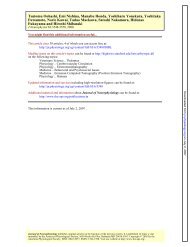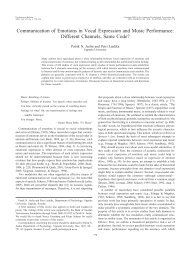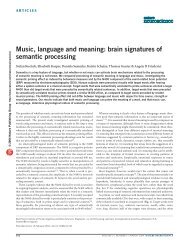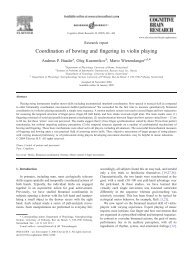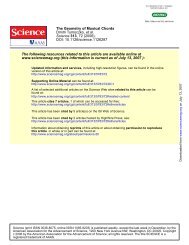The musician's brain as a model of neuroplasticity
The musician's brain as a model of neuroplasticity
The musician's brain as a model of neuroplasticity
Create successful ePaper yourself
Turn your PDF publications into a flip-book with our unique Google optimized e-Paper software.
PERSPECTIVESOPINION<strong>The</strong> musician’s <strong>brain</strong> <strong>as</strong> a <strong>model</strong><strong>of</strong> neuropl<strong>as</strong>ticityThom<strong>as</strong> F. Münte, Eckart Altenmüller and Lutz JänckeStudies <strong>of</strong> experience-driven neuropl<strong>as</strong>ticityat the behavioural, ensemble, cellular andmolecular levels have shown that thestructure and significance <strong>of</strong> the elicitingstimulus can determine the neural changesthat result. Studying such effects in humansis difficult, but pr<strong>of</strong>essional musiciansrepresent an ideal <strong>model</strong> in which toinvestigate pl<strong>as</strong>tic changes in the human<strong>brain</strong>. <strong>The</strong>re are two advantages tostudying pl<strong>as</strong>ticity in musicians: thecomplexity <strong>of</strong> the eliciting stimulus — music— and the extent <strong>of</strong> their exposure to thisstimulus. Here, we focus on the functionaland anatomical differences that have beendetected in musicians by modernneuroimaging methods.related pl<strong>as</strong>ticity, <strong>as</strong> is its behavioural significance3,4 . Animal research h<strong>as</strong> also revealedneuropl<strong>as</strong>ticity at the molecular, synaptic andmacroscopic structural levels 5,6 . Although animal<strong>model</strong>s are useful for studying the cellularand molecular mechanisms <strong>of</strong> pl<strong>as</strong>ticity, thetypical laboratory animal is deprived <strong>of</strong> normalstimulation and might, therefore, be <strong>as</strong>pecial c<strong>as</strong>e. Moreover, animal <strong>model</strong>s are limitedin the range <strong>of</strong> stimuli that are used, in thebehavioural manipulations that are <strong>as</strong>sociatedwith these stimuli and in the duration <strong>of</strong>training. In addition, it is far from clear howthe mechanisms that govern synaptic pl<strong>as</strong>ticityat the cellular level are related to theflexibility <strong>of</strong> operations seen for large-scaleneuronal networks on the one hand, andcognitive processes on the other.It is therefore important to extend theseinvestigations to the human <strong>brain</strong>. Significantheadway h<strong>as</strong> been made by studying intermodalpl<strong>as</strong>ticity in congenitally blind 7 or deafsubjects 8,9 , or by monitoring the effects <strong>of</strong>limb amputations 10 . In this article, however,we are concerned with findings in pr<strong>of</strong>essionalmusicians that have been describedover the p<strong>as</strong>t decade or so. Performing musicat a pr<strong>of</strong>essional level is arguably among themost complex <strong>of</strong> human accomplishments. Apianist, for example, h<strong>as</strong> to bimanually coordinatethe production <strong>of</strong> up to 1,800 notesper minute (FIG. 1). Music, <strong>as</strong> a sensory stimulus,is highly complex and structured in severaldimensions 11 , so it extends beyond any <strong>of</strong>the stimuli that have been used in animalresearch. Moreover, making music requires<strong>The</strong> size and temporal organization <strong>of</strong> corticalrepresentations <strong>of</strong> stimuli are continuallyshaped by experience 1,2 . Animal studies overthe p<strong>as</strong>t 20 years have gone a long way towardsexplaining some <strong>of</strong> the rules <strong>of</strong> cortical pl<strong>as</strong>ticity.For example, it h<strong>as</strong> been shown that trainingto make fine-grained temporal judgementsyields an expansion <strong>of</strong> the bandwidthor receptive field in both the auditory andsomatosensory modalities, where<strong>as</strong> t<strong>as</strong>ks thatrequire fine-grained frequency or spatial tactilediscrimination lead to a decre<strong>as</strong>e in thereceptive-field size <strong>of</strong> cortical neurons 1,3 . Thiseffect h<strong>as</strong> been explained by Hebbian learningrules, whereby synapses are driven to changeby temporally coherent inputs in a competitiveneural network. Attention to the sensoryinput is very important in driving experience-3 secondsFigure 1 | Example <strong>of</strong> a hypercomplex musical score. Two three-second segments <strong>of</strong> the 11thvariation from the 6th Paganini-Etude by Franz Liszt. <strong>The</strong> depicted segments require the production <strong>of</strong>1,800 notes per minute. Reproduced by kind permission <strong>of</strong> Peters Edition Ltd.NATURE REVIEWS | NEUROSCIENCE VOLUME 3 | JUNE 2002 | 473© 2002 Nature Publishing Group
PERSPECTIVESthe integration <strong>of</strong> sensory and motor information,and precise monitoring <strong>of</strong> performance.Finally, the study <strong>of</strong> musicians mightallow us to te<strong>as</strong>e apart the effects <strong>of</strong> musicaltraining or experience from those <strong>of</strong> geneticpredisposition.So, the musician’s <strong>brain</strong> might constitute aperfect <strong>model</strong> in which to study neuropl<strong>as</strong>ticityin the auditory and motor domains. It can alsobe used to examine the effects <strong>of</strong> dysfunctionalpl<strong>as</strong>ticity, <strong>as</strong> illustrated by musician’s cramp, aparticular kind <strong>of</strong> occupational dystonia 12,13 .Functional me<strong>as</strong>ures <strong>of</strong> pl<strong>as</strong>ticityIn a seminal study in 1995, Elbert and colleagues14 investigated somatosensory evokedmagnetic fields in string players. Sourceanalysis revealed that the cortical representation<strong>of</strong> the digits <strong>of</strong> the left hand (the fingeringhand) w<strong>as</strong> larger in these musicians thanin controls. In the c<strong>as</strong>e <strong>of</strong> the right hand, inwhich no independent movements <strong>of</strong> the fingersare required in string players, there wereno differences between musicians and controls.<strong>The</strong> cortical reorganization <strong>of</strong> the representation<strong>of</strong> the fingers w<strong>as</strong> more pronouncedin musicians who had begun their musicaltraining at an early age. A first indication thatextensive musical training can pl<strong>as</strong>tically alterreceptive functions w<strong>as</strong> provided by Pantevand colleagues 15 . Equivalent current dipoles,computed from evoked magnetic fields, wereobtained in response to piano tones and topure tones <strong>of</strong> equal fundamental frequencyand loudness. In musicians, the responses topiano tones (but not to pure tones) were~25% larger than in non-musicians. In <strong>as</strong>tudy <strong>of</strong> violinists and trumpeters, this effectw<strong>as</strong> most pronounced for tones from eachmusician’s own type <strong>of</strong> instrument 16 .Although musical sounds were used inthese early studies, they lacked a main characteristic<strong>of</strong> music: tones become music onlywhen they are structured. <strong>The</strong> temporalstructure <strong>of</strong> music comprises local rhythm,defined by the duration and temporal distance<strong>of</strong> tones, and global metrum, whichdetermines whether a piece is, for example, amarch or a waltz. As far <strong>as</strong> the pitch dimensionis concerned, the interval between twosuccessive notes, the global contour <strong>of</strong> a musicalpiece and the harmonic structure can bedistinguished. In processing (and enjoying)music, the extraction <strong>of</strong> structural regularitiesis <strong>of</strong> paramount importance. At what cognitiveand neural levels are such regularities <strong>of</strong>music processed? <strong>The</strong> mismatch negativity(MMN), a frontal negative wave in the eventrelatedpotential (ERP), is a marker <strong>of</strong> thepre-attentive detection <strong>of</strong> changes in regularsequences <strong>of</strong> auditory stimuli 17 . Consider, forFigure 2 | Structural changes in the <strong>brain</strong>s <strong>of</strong>musicians. Some <strong>of</strong> the <strong>brain</strong> are<strong>as</strong> that havebeen found to be enlarged in musicians inmorphometric studies b<strong>as</strong>ed on structuralmagnetic resonance imaging. Red, primary motorcortex; yellow, planum temporale; orange, anteriorpart <strong>of</strong> the corpus callosum.example, a series <strong>of</strong> 1,200-Hz tones that isinterrupted occ<strong>as</strong>ionally by a deviant 1,500-Hztone. In this situation, the deviant tones giverise to an MMN. Importantly, the MMNoccurs in the absence <strong>of</strong> attention to the stimuli,and newer research h<strong>as</strong> indicated that, inaddition to simple physical deviants (such <strong>as</strong>duration, pitch or intensity), the MMN is alsoelicited by more complex irregularities, such<strong>as</strong> changes in sequences <strong>of</strong> several tones 17 .Pr<strong>of</strong>essional musicians, unlike non-musicians,show an MMN for tones that aremistimed by <strong>as</strong> little <strong>as</strong> 20 ms in a series <strong>of</strong>regularly spaced tones 18 . For stimuli that aremistimed by 50 ms, which do produce anMMN in non-musicians, the MMN in musiciansw<strong>as</strong> considerably larger than that <strong>of</strong> controls18 . Musicians also showed an MMN forslightly impure chords that were presentedamong perfect major chords, where<strong>as</strong>, again,non-musicians did not 19 . Recently, an MMNw<strong>as</strong> found for small changes in the contour <strong>of</strong>transposed melodies in musicians who performprimarily without a score 20 . Source localizationstudies have shown that the MMNarises mainly from neurons on the supratemporalplain <strong>of</strong> the temporal lobe, withfurther contributions from the frontal cortex17,21,22 . <strong>The</strong>se findings indicate that, afteryears <strong>of</strong> musical training, neuronal populationsin the auditory cortex might be shapedsuch that they automatically detect subtlechanges in auditory stimulus sequences withsimple or higher-order regularities. <strong>The</strong> parametersthat are needed for the acquisition <strong>of</strong>these skills are unknown, but probably involveinitial attentive processing <strong>of</strong> the stimuli 20 .In an experiment that required theattentive analysis <strong>of</strong> chord sequences, the N1component <strong>of</strong> the ERP, which arises from theprimary auditory cortex, w<strong>as</strong> enhanced inresponse to consonant chords, relative to dissonant(augmented fifth) chords, in musiciansonly 23 . This indicates that the auditorycortex, possibly including the primary are<strong>as</strong>,in musicians might be tuned to complexharmonic features <strong>of</strong> sounds 24 .Superiorattention-dependent processing in musiciansw<strong>as</strong> also shown in a study that required thesubjects to select stimuli from one <strong>of</strong> twoinformation channels that were defined bytheir pitch. In such situations, stimuli that areattended elicit a negativity in the event-relatedpotential, known <strong>as</strong> the Nd, relative to stimulithat are not the focus <strong>of</strong> attention 25 . In pr<strong>of</strong>essionalmusicians, the Nd w<strong>as</strong> more pronounced,indicating superior attentionalselectivity in the pitch dimension 26 .A recurring theme in the animal literatureis the pl<strong>as</strong>ticity <strong>of</strong> sound localization. Interauraldifferences in the level and ph<strong>as</strong>e <strong>of</strong>sounds are important for sound localization,but the filter functions <strong>of</strong> the outer ear,known <strong>as</strong> head-related transfer functions 27 ,also provide crucial information. A conductor,more than any other musician, is likely todepend on spatial localization for successfulperformance — for example, he might needto home in on a certain player. Consistentwith this, pr<strong>of</strong>essional conductors were foundto be better than pianists and non-musiciansat separating adjacent sound sources, one<strong>of</strong> which w<strong>as</strong> t<strong>as</strong>k relevant, in the periphery <strong>of</strong>the auditory field. This behavioural selectivityw<strong>as</strong> paralleled by modulation <strong>of</strong> the Nd component,which w<strong>as</strong> selective for the attendedsource in conductors, but not in pianists ornon-musicians 28 .Anatomical differencesSince the age <strong>of</strong> phrenology, neuroscientistshave tried to relate extraordinary skills tochanges in <strong>brain</strong> anatomy. For example, atthe beginning <strong>of</strong> the twentieth century,Auerbach reported that the middle and posteriorthirds <strong>of</strong> the superior temporal gyruswere larger than normal in several postmortemstudies <strong>of</strong> the <strong>brain</strong>s <strong>of</strong> famousmusicians 29 . Modern <strong>brain</strong>-imaging techniques,such <strong>as</strong> high-resolution magnetic resonanceimaging (MRI), allow us to studyanatomical details in the <strong>brain</strong>s <strong>of</strong> livinghumans. Studies in which these techniqueshave been used have shown that several <strong>brain</strong>are<strong>as</strong>, including the planum temporale, theanterior corpus callosum, the primary handmotor area and the cerebellum, differ in theirstructure and size between musicians andcontrol subjects (FIG. 2). <strong>The</strong>se findings havereopened the debate about whether thesestructural differences are related directly tomusical ability.474 | JUNE 2002 | VOLUME 3 www.nature.com/reviews/neuro© 2002 Nature Publishing Group
PERSPECTIVESwhich is comparable to the oral–aural loop inlanguage processing — is established duringmusical training 48 . At the behavioural level, itis reflected by reports from pr<strong>of</strong>essionalpianists that their fingers move more-or-lessautomatically when they are listening to pianomusic. Exposing musically naive subjects tocontrolled piano training led to audio-motorcoupling after <strong>as</strong> little <strong>as</strong> 20 minutes <strong>of</strong> training,<strong>as</strong> shown by topographic analysis <strong>of</strong> veryslow event-related potentials 48 . After the firsttraining session, there w<strong>as</strong> further activity overmotor are<strong>as</strong> while subjects listened to simplepiano tunes. Likewise, finger movements on amute keyboard were <strong>as</strong>sociated with anincre<strong>as</strong>e in activity over auditory are<strong>as</strong>. <strong>The</strong>effect could be enhanced and stabilized duringfive weeks <strong>of</strong> training (FIG. 3). Similar co-activationh<strong>as</strong> also been found in pr<strong>of</strong>essionalpianists, who showed magnetoencephalographic(MEG) activity in sensorimotorListening20 years0.9820 days0.9520 minutes0.83Start0.78MovingnegposFigure 3 | Sensorimotor integration inmusicians. Shown are spline-interpolatedisovoltage maps <strong>of</strong> averaged electroencephalographicrecordings. Subjects eitherlistened to a short piece <strong>of</strong> piano music (leftcolumn) or performed on a mute piano keyboard(right column). Before training, musically naivesubjects (Start) produced grossly differenttopographic patterns <strong>of</strong> slow event-relatedpotentials in the two conditions, <strong>as</strong> indicated bythe maps and a me<strong>as</strong>ure <strong>of</strong> map similarity (scalarproduct). With training for 20 minutes or 20 days,the topographic distributions became incre<strong>as</strong>inglysimilar. In pr<strong>of</strong>essional pianists with approximately20 years <strong>of</strong> training, maps in both conditions arevirtually identical. Modified, with permission, fromREF. 48 © 2001 New York Academy <strong>of</strong> Sciences.cortical regions while listening to pianomusic 49 . <strong>The</strong>se neural networks thus seem tobehave in a similar way to the ‘mirror neurons’in the monkey frontal cortex (area F5), whichare active during both the execution <strong>of</strong> complexmovements and visual observation <strong>of</strong> thesame movements 50 .Maladaptive pl<strong>as</strong>ticity<strong>The</strong>re is a dark side to the incre<strong>as</strong>ing specializationand prolonged training <strong>of</strong> modernmusicians — namely, loss <strong>of</strong> control anddegradation <strong>of</strong> skilled hand movements, adisorder referred to <strong>as</strong> ‘musicians’ cramp’ orfocal dystonia 12 . <strong>The</strong> first historical record <strong>of</strong>this condition, from 1830, appears in thediaries <strong>of</strong> the famous pianist and composerRobert Schumann 51 . As w<strong>as</strong> probably the c<strong>as</strong>efor Schumann, prolonged practice and painsyndromes due to overuse can precipitate dystonia,which is developed by ~1% <strong>of</strong> pr<strong>of</strong>essionalmusicians and usually ends theircareers 12 . Neuroimaging studies point to dysfunctional(or maladaptive) neuropl<strong>as</strong>ticity <strong>as</strong>its cause 13,52 . For example, an MEG study <strong>of</strong>musicians with focal dystonia showed fusion<strong>of</strong> the digital representations in the somatosensorycortex, reflected in a decre<strong>as</strong>ed distancebetween the representations <strong>of</strong> theindex and little fingers relative to healthy controlmusicians 13 (FIG. 4). <strong>The</strong>se findings arecorroborated by psychophysical me<strong>as</strong>urementsand fMRI investigations in a relateddisorder, writer’s cramp, which showeddecre<strong>as</strong>ed temporal and spatial discriminationat the finger tips 53,54 . Observations inmonkeys indicate that rapid, stereotypicalmovements in a learning context can activelydegrade the cortical representations <strong>of</strong> sensoryinformation that guide fine hand movements55 . This dedifferentiation <strong>of</strong> sensoryfeedback information h<strong>as</strong> been proposed t<strong>of</strong>orm the b<strong>as</strong>is <strong>of</strong> focal dystonia 47,55 . Indeed,the repeated temporal <strong>as</strong>sociation <strong>of</strong> movementpatterns is a characteristic <strong>of</strong> music —for example, when playing arpeggios or musicalscales. In a further study, symptoms wereprovoked in five dystonic guitarists when theyplayed a modified guitar inside an fMRI scanner56 . Relative to non-dystonic guitarists, theyshowed more activation <strong>of</strong> the contralateralsensorimotor cortex but less activation <strong>of</strong> premotorare<strong>as</strong>, indicating abnormal recruitment<strong>of</strong> cortical are<strong>as</strong> that are involved in thecontrol <strong>of</strong> complex movements.Musicians <strong>as</strong> a <strong>model</strong>?Neuropl<strong>as</strong>ticity allows the <strong>brain</strong> to adapt toenvironmental factors that cannot be anticipatedby genetic programming. <strong>The</strong> neuraland behavioural changes that are attributedto pl<strong>as</strong>ticity have been observed on differenttimescales, ranging from several minutes tothe whole lifetime <strong>of</strong> the individual.Different processes are likely to supportpl<strong>as</strong>tic changes at the extremes <strong>of</strong> this timeline.Accordingly, experience-driven neuropl<strong>as</strong>ticityh<strong>as</strong> been explained by both thede novo growth and improvement <strong>of</strong> newdendrites, synapses and neurons 5,57 , and thedisinhibition or inhibition <strong>of</strong> pre-existinglateral connections between neurons bysensory input 58 . <strong>The</strong> former mechanismentails structural changes at the microscopicand macroscopic levels, where<strong>as</strong> the lattercan be achieved by strengthening or inhibitingpre-existing synaptic connections in thespirit <strong>of</strong> Hebbian learning. Sometimes, evenmore rapid changes <strong>of</strong> <strong>brain</strong> responses,occurring in the order <strong>of</strong> milliseconds, havebeen discussed under the heading <strong>of</strong> neuropl<strong>as</strong>ticity.However, these are likely to resultfrom the attentional modulation <strong>of</strong> neuralcircuits, and should be distinguished fromtrue pl<strong>as</strong>tic changes 59 .Research into pl<strong>as</strong>ticity in musicians is still inits infancy, but, already, many <strong>of</strong> the findingsfrom animal studies have found parallels instudies <strong>of</strong> musicians. At one extreme, years <strong>of</strong>musical experience, especially in those musicianswho begin training early on, might lead toan incre<strong>as</strong>e in grey and white matter volume inseveral <strong>brain</strong> regions 31,32,36,39,41 . <strong>The</strong>se anatomicalalterations seem to be confined to a criticalperiod. <strong>The</strong> fact that, in several studies, a correlationw<strong>as</strong> found between the extent <strong>of</strong> theanatomical differences and the age at whichmusical training started strongly argues againstthe possibility that these differences are preexistingand the cause, rather than the result, <strong>of</strong>practising music. <strong>The</strong> view that these differencesrepresent genuine pl<strong>as</strong>tic changes <strong>of</strong> the <strong>brain</strong>receives further support from neuroimagingstudies in other populations. For example, acorrelation between the size <strong>of</strong> the posteriorhippocampus and years <strong>of</strong> driving experienceh<strong>as</strong> been reported in London taxi drivers 60 .Further research using advanced imaging techniques,such <strong>as</strong> magnetic resonance spectroscopyand diffusion tensor imaging, and theextension <strong>of</strong> studies beyond the conventionalcross-sectional design, are needed to investigatethe underlying neurophysiological changes.At the other extreme, several minutes <strong>of</strong>training can induce changes in the recruitment<strong>of</strong> are<strong>as</strong> <strong>of</strong> the motor cortex 44 or establishauditory–sensorimotor coupling 48 .Some <strong>of</strong> the other findings discussed hereprobably require training in the order <strong>of</strong>months to several years and, at present, it isunclear what neural processes support thisbehavioural pl<strong>as</strong>ticity.476 | JUNE 2002 | VOLUME 3 www.nature.com/reviews/neuro© 2002 Nature Publishing Group
PERSPECTIVESD5D2–D4D1Non-dystonic hand<strong>The</strong> investigations presented in thisoverview convincingly show the value <strong>of</strong> themusician’s <strong>brain</strong> <strong>as</strong> a <strong>model</strong> <strong>of</strong> neuropl<strong>as</strong>ticityand have set the stage for furtherresearch. Some <strong>of</strong> the questions that need tobe tackled include the following. What arethe training parameters that lead to successfullearning and pl<strong>as</strong>ticity? Can these parametersbe exploited in musical education orto enhance learning in other domains? Whatis the role <strong>of</strong> genes in determining auditoryneuropl<strong>as</strong>ticity in musicians? What is therange <strong>of</strong> structural regularities that can beextracted from the auditory input in anautomatic, pre-attentive f<strong>as</strong>hion? As makingmusic undoubtedly requires intense selfmonitoring,and error detection and correction,are there any pl<strong>as</strong>tic changes in theexecutive <strong>brain</strong> systems that are responsiblefor performance monitoring?Finally, one h<strong>as</strong> to bear in mind that musiccan elicit powerful emotional reactions.Strong emotional responses to music, leadingAffected digitsD3–D5RightLeftFigure 4 | Fusion <strong>of</strong> the somatosensory representation <strong>of</strong> single digits <strong>of</strong> the hand in a musiciansuffering from focal dystonia. <strong>The</strong> best-fitting dipoles to explain the evoked magnetic fields aftersensory stimulation <strong>of</strong> single digits (D1–D5) are shown projected on the individual’s magnetic resonanceimaging scan. Where<strong>as</strong> for the non-affected hand, the typical homuncular organization (inset) reveals adistance <strong>of</strong> ~2.5 cm between the sources for the thumb and the little finger (yellow circle and square onthe right <strong>of</strong> the <strong>brain</strong>), the somatosensory representations <strong>of</strong> the fingers on the dystonic side are blurred,resulting from a fusion <strong>of</strong> the neural networks that process incoming sensory stimuli from different fingers(red circles). Modified, with permission, from REF. 13 © 1998 Lippincott, Williams and Wilkins.D1D2to shivers down the spine and changes in heartrate, are accompanied by the activation <strong>of</strong> a<strong>brain</strong> network that includes the ventral striatum,mid<strong>brain</strong>, amygdala, orbit<strong>of</strong>rontal cortexand ventral medial prefrontal cortex — are<strong>as</strong>that are thought to be involved in reward,emotion and motivation 61 . Further researchwill show whether activity in these are<strong>as</strong> is alsodirectly involved in mediating neuropl<strong>as</strong>ticity.Thom<strong>as</strong> F. Münte is at the Department <strong>of</strong>Neuropsychology, Otto-von-Guericke University,Universitätsplatz 2, Gebäude 24,39106 Magdeburg, Germany.Eckart Altenmüller is at the Institute <strong>of</strong> MusicPhysiology and Musicians’ Medicine, HannoverSchool <strong>of</strong> Music and Drama, Emmich Platz 1,30175 Hannover, Germany.Lutz Jäncke is at the Department <strong>of</strong>Neuropsychology, University <strong>of</strong> Zürich, ZürichbergStr<strong>as</strong>se 43, CH-8044 Zürich, Switzerland.Correspondence to T.F.M.e-mail: thom<strong>as</strong>.muente@med.uni-magdeburg.dedoi:10.1038/nrn8431. Kilgard, M. P. et al. Sensory input directs spatial andtemporal pl<strong>as</strong>ticity in primary auditory cortex.J. Neurophysiol. 86, 326–338 (2001).2. Singer, W. Development and pl<strong>as</strong>ticity <strong>of</strong> corticalprocessing architectures. Science 270, 758–764(1995).3. Recanzone, G. H., Merzenich, M. M., Jenkins, W. M.,Grajski, K. A. & Dinse, H. R. Topographic reorganization<strong>of</strong> the hand representation in cortical area 3b <strong>of</strong> owlmonkeys trained in a frequency-discrimination t<strong>as</strong>k.J. Neurophysiol. 67, 1031–1056 (1992).4. Ahissar, M. & Hochstein, S. T<strong>as</strong>k difficulty and thespecificity <strong>of</strong> perceptual learning. Nature 387, 401–406(1997).5. Anderson, B. J. et al. Glial hypertrophy is <strong>as</strong>sociated withsynaptogenesis following motor-skill learning, but notwith angiogenesis following exercise. Glia 11, 73–80(1994).6. van Praag, H., Kempermann, G. & Gage, F. H. Neuralconsequences <strong>of</strong> environmental enrichment. Nature Rev.Neurosci. 1, 191–198 (2000).7. Röder, B. et al. Improved auditory spatial tuning in blindhumans. Nature 400, 162–166 (1999).8. Bavelier, D. et al. Visual attention to the periphery isenhanced in congenitally deaf individuals. J. Neurosci.20, RC93 (2000).9. Bavelier, D. & Neville, H. J. Cross-modal pl<strong>as</strong>ticity: whereand how? Nature Rev. Neurosci. 3, 443–452 (2002).10. Flor, H. et al. Phantom-limb pain <strong>as</strong> a perceptual correlate<strong>of</strong> cortical reorganization following arm amputation.Nature 375, 482–484 (1995).11. Schuppert, M., Münte, T. F., Wieringa, B. M. &Altenmüller, E. Receptive amusia: evidence for crosshemisphericneural networks underlying musicprocessing strategies. Brain 123, 546–559 (2000).12. Lim, V. K., Altenmüller, E. & Bradshaw, J. L. Focal dystonia:current theories. Hum. Mov. Sci. 20, 875–914 (2001).13. Elbert, T. et al. Alteration <strong>of</strong> digital representations insomatosensory cortex in focal hand dystonia.Neuroreport 9, 3571–3575 (1998).14. Elbert, T., Pantev, C., Wienbruch, C., Rockstroh, B. &Taub, E. Incre<strong>as</strong>ed cortical representation <strong>of</strong> the fingers <strong>of</strong>the left hand in string players. Science 270, 305–307(1995).15. Pantev, C. et al. Incre<strong>as</strong>ed auditory cortical representationin musicians. Nature 392, 811–814 (1998).16. Pantev, C., Roberts, L. E., Schulz, M., Engelien, A. &Ross, B. Timbre-specific enhancement <strong>of</strong> auditorycortical representations in musicians. Neuroreport 12,169–174 (2001).17. Picton, T. W., Alain, C., Otten, L., Ritter, W. & Achim, A.Mismatch negativity: different water in the same river.Audiol. Neurootol. 5, 111–139 (2000).18. Russeler, J., Altenmüller, E., Nager, W., Kohlmetz, C. &Münte, T. F. Event-related <strong>brain</strong> potentials to soundomissions differ in musicians and non-musicians.Neurosci. Lett. 308, 33–36 (2001).19. Koelsch, S., Schroger, E. & Tervaniemi, M. Superior preattentiveauditory processing in musicians. Neuroreport10, 1309–1313 (1999).20. Tervaniemi, M., Rytkonen, M., Schroger, E., Ilmoniemi,R. J. & Näätänen, R. Superior formation <strong>of</strong> corticalmemory traces for melodic patterns in musicians.Learn. Mem. 8, 295–300 (2001).21. Tiitinen, H. et al. Tonotopic auditory cortex and themagnetoencephalographic (MEG) equivalent <strong>of</strong> themismatch negativity. Psychophysiology 30, 537–540(1993).22. Tervaniemi, M. et al. Functional specialization <strong>of</strong> thehuman auditory cortex in processing phonetic andmusical sounds: a magnetoencephalographic (MEG)study. Neuroimage 9, 330–336 (1999).23. Regnault, P., Bigand, E. & Besson, M. Different <strong>brain</strong>mechanisms mediate sensitivity to sensory consonanceand harmonic context: evidence from auditory eventrelated<strong>brain</strong> potentials. J. Cogn. Neurosci. 13,241–255 (2001).24. Tramo, M. J., Cariani, P. A., Delgutte, B. & Braida, L. D.Neurobiological foundations for the theory <strong>of</strong> harmony inwestern tonal music. Ann. NY Acad. Sci. 930, 92–116(2001).25. Hillyard, S. A., Teder-Salejarvi, W. A. & Münte, T. F.Temporal dynamics <strong>of</strong> early perceptual processing.Curr. Opin. Neurobiol. 8, 202–210 (1998).26. Münte, T. F., Nager, W., Rosenthal, O., Johannes, S. &Altenmüller, E. in Integrated Human Brain Science (ed.Nakada, T.) 389–398 (Elsevier, Amsterdam, 2000).27. Musicant, A. D., Chan, J. C. & Hind, J. E. Directiondependentspectral properties <strong>of</strong> cat external ear: newdata and cross-species comparisons. J. Acoust. Soc.Am. 87, 757–781 (1990).NATURE REVIEWS | NEUROSCIENCE VOLUME 3 | JUNE 2002 | 477© 2002 Nature Publishing Group
PERSPECTIVES28. Münte, T. F., Kohlmetz, C., Nager, W. & Altenmüller, E.Neuroperception. Superior auditory spatial tuning inconductors. Nature 409, 580 (2001).29. Meyer, A. in Music and the Brain (eds Macdonald, C. &Henson, R. A.) 255–281 (Heinemann Medical Books,London, 1977).30. Jäncke, L., Schlaug, G., Huang, Y. & Steinmetz, H.Asymmetry <strong>of</strong> the planum parietale. Neuroreport 5,1161–1163 (1994).31. Schlaug, G., Jäncke, L., Huang, Y. & Steinmetz, H.In vivo evidence <strong>of</strong> structural <strong>brain</strong> <strong>as</strong>ymmetry inmusicians. Science 267, 699–701 (1995).32. Keenan, J. P., Thangaraj, V., Halpern, A. R. & Schlaug, G.Absolute pitch and planum temporale. Neuroimage 14,1402–1408 (2001).33. Zatorre, R. J., Perry, D. W., Beckett, C. A., Westbury, C.F. & Evans, A. C. Functional anatomy <strong>of</strong> musicalprocessing in listeners with absolute pitch and relativepitch. Proc. Natl Acad. Sci. USA 95, 3172–3177 (1998).34. Amunts, K. et al. Hand skills covary with the size <strong>of</strong> motorcortex: a macrostructural adaptation. Hum. Brain Mapp.5, 206–215 (1997).35. Jäncke, L., Schlaug, G. & Steinmetz, H. Hand skill<strong>as</strong>ymmetry in pr<strong>of</strong>essional musicians. Brain Cogn. 34,424–432 (1997).36. Schlaug, G., Jäncke, L., Huang, Y., Staiger, J. F. &Steinmetz, H. Incre<strong>as</strong>ed corpus callosum size inmusicians. Neuropsychologia 33, 1047–1055 (1995).37. Aboitiz, F., Scheibel, A. B., Fisher, R. S. & Zaidel, E. Fibercomposition <strong>of</strong> the human corpus callosum. Brain Res.598, 143–153 (1992).38. Ridding, M. C., Brouwer, B. & Nordstrom, M. A. Reducedinterhemispheric inhibition in musicians. Exp. Brain Res.133, 249–253 (2000).39. Schlaug, G. <strong>The</strong> <strong>brain</strong> <strong>of</strong> musicians. A <strong>model</strong> forfunctional and structural adaptation. Ann. NY Acad. Sci.930, 281–299 (2001).40. Ashburner, J. & Friston, K. J. Voxel-b<strong>as</strong>ed morphometry— the methods. Neuroimage 11, 805–821 (2002).41. G<strong>as</strong>er, C. & Schlaug, G. Brain structures differ betweenmusicians and non-musicians. Neuroimage 13, 1168(2001).42. Karni, A. et al. <strong>The</strong> acquisition <strong>of</strong> skilled motorperformance: f<strong>as</strong>t and slow experience-driven changes inprimary motor cortex. Proc. Natl Acad. Sci. USA 95,861–868 (1998).43. Karni, A. et al. Functional MRI evidence for adult motorcortex pl<strong>as</strong>ticity during motor skill learning. Nature 377,155–158 (1995).44. Hund-Georgiadis, M. & von Cramon, D. Y. Motor-learningrelatedchanges in piano players and non-musiciansrevealed by functional magnetic-resonance signals.Exp. Brain Res. 125, 417–425 (1999).45. Jäncke, L., Shah, N. J. & Peters, M. Cortical activationsin primary and secondary motor are<strong>as</strong> for complexbimanual movements in pr<strong>of</strong>essional pianists. Brain Res.Cogn. Brain Res. 10, 177–183 (2000).46. Krings, T. et al. Cortical activation patterns duringcomplex motor t<strong>as</strong>ks in piano players and controlsubjects. A functional magnetic resonance imagingstudy. Neurosci. Lett. 278, 189–193 (2000).47. P<strong>as</strong>cual-Leone, A. <strong>The</strong> <strong>brain</strong> that plays music and ischanged by it. Ann. NY Acad. Sci. 930, 315–329 (2001).48. Bangert, M., Haeusler, U. & Altenmüller, E. On practice:how the <strong>brain</strong> connects piano keys and piano sounds.Ann. NY Acad. Sci. 930, 425–428 (2001).49. Haueisen, J. & Knosche, T. R. Involuntary motor activity inpianists evoked by music perception. J. Cogn. Neurosci.13, 786–792 (2001).50. Umilta, M. A. et al. I know what you are doing. Aneurophysiological study. Neuron 31, 155–165 (2001).51. Schumann, R. Tagebücher, Band 1 (Stroemfeld RoterStern, B<strong>as</strong>el, 1971).52. Byl, N. N., McKenzie, A. & Nagarajan, S. S. Differences insomatosensory hand organization in a healthy flutist anda flutist with focal hand dystonia: a c<strong>as</strong>e report. J. Hand<strong>The</strong>r. 13, 302–309 (2000).53. Sanger, T. D., Tarsy, D. & P<strong>as</strong>cual-Leone, A. Abnormalities<strong>of</strong> spatial and temporal sensory discrimination in writer’scramp. Mov. Disord. 16, 94–99 (2001).54. Sanger, T. D., P<strong>as</strong>cual-Leone, A., Tarsy, D. & Schlaug, G.Nonlinear sensory cortex response to simultaneous tactilestimuli in writer’s cramp. Mov. Disord. 17, 105–111 (2002).55. Byl, N. N., Merzenich, M. M. & Jenkins, W. M. A primategenesis <strong>model</strong> <strong>of</strong> focal dystonia and repetitive straininjury. I. Learning-induced dedifferentiation <strong>of</strong> therepresentation <strong>of</strong> the hand in the primary somatosensorycortex in adult monkeys. Neurology 47, 508–520 (1996).56. Pujol, J. et al. Brain cortical activation during guitarinducedhand dystonia studied by functional MRI.Neuroimage 12, 257–267 (2000).57. Polat, U. & Sagi, D. Spatial interactions in human vision:from near to far via experience-dependent c<strong>as</strong>cades <strong>of</strong>connections. Proc. Natl Acad. Sci. USA 91, 1206–1209(1994).58. Jacobs, K. M. & Donoghue, J. P. Reshaping the corticalmotor map by unm<strong>as</strong>king latent intracorticalconnections. Science 251, 944–947 (1991).59. Noppeney, U., Waberski, T. D., Gobbele, R. & Buchner,H. Spatial attention modulates the corticalsomatosensory representation <strong>of</strong> the digits in humans.Neuroreport 10, 3137–3141 (1999).60. Maguire, E. A. et al. Navigation-related structural changein the hippocampi <strong>of</strong> taxi drivers. Proc. Natl Acad. Sci.USA 97, 4398–4403 (2000).61. Blood, A. J. & Zatorre, R. J. Intensely ple<strong>as</strong>urableresponses to music correlate with activity in <strong>brain</strong> regionsimplicated in reward and emotion. Proc. Natl Acad. Sci.USA 98, 11818–11823 (2001).62. Pr<strong>of</strong>ita, J. & Bidder, T. G. Perfect pitch. Am. J. Med.Genet. 29, 763–771 (1988).63. Baharloo, S., Johnston, P. A., Service, S. K., Gitschier, J.& Freimer, N. B. Absolute pitch: an approach foridentification <strong>of</strong> genetic and nongenetic components.Am. J. Hum. Genet. 62, 224–231 (1998).64. Revesz, G. Introduction to the Psychology <strong>of</strong> Music(Longmans Green, London, 1953).65. Baharloo, S., Service, S. K., Risch, N., Gitschier, J. &Freimer, N. B. Familial aggregation <strong>of</strong> absolute pitch.Am. J. Hum. Genet. 67, 755–758 (2000).OPINION66. Gregersen, P. K., Kowalsky, E., Kohn, N. & Marvin, E. W.Absolute pitch: prevalence, ethnic variation, andestimation <strong>of</strong> the genetic component. Am. J. Hum.Genet. 65, 911–913 (1999).67. Ohnishi, T. et al. Functional anatomy <strong>of</strong> musical perceptionin musicians. Cereb. Cortex 11, 754–760 (2001).68. Crummer, G. C., Walton, J. P., Wayman, J. W., Hantz,E. C. & Frisina, R. D. Neural processing <strong>of</strong> musical timbreby musicians, nonmusicians, and musicians possessingabsolute pitch. J. Acoust. Soc. Am. 95, 2720–2727(1994).69. Klein, M., Coles, M. G. H. & Donchin, E. People withabsolute pitch process tones without producing a P300.Science 233, 1306–1309 (1984).Online linksFURTHER INFORMATIONEncyclopedia <strong>of</strong> Life Sciences: http://www.els.net/auditory processing | <strong>brain</strong> imaging: observing ongoing neuralactivity | cortical pl<strong>as</strong>ticity: use-dependent re<strong>model</strong>ling |magnetic resonance imaging | topographic maps in the <strong>brain</strong>MIT Encyclopedia <strong>of</strong> Cognitive Sciences:http://cognet.mit.edu/MITECS/auditory pl<strong>as</strong>ticity | electrophysiology, electric and magneticevoked fields | magnetic resonance imaging | neural pl<strong>as</strong>ticity |positron emission tomographyAccess to this interactive links box is free online.Complex-trait genetics: emergence <strong>of</strong>multivariate strategiesTamara J. Phillips and John K. BelknapComplex traits, including many dise<strong>as</strong>erelatedtraits, are influenced by multiplegenes. Bivariate approaches that <strong>as</strong>sociateone gene with one trait are yielding tomultivariate methods to synthesize theeffects <strong>of</strong> multiple genes, integrate resultsacross independent studies, and aid in theidentification <strong>of</strong> coordinated pathways andinteractions between loci.<strong>The</strong> extraordinary success <strong>of</strong> the molecularrevolution in transforming modern biologyh<strong>as</strong> generated one important problem — howdo we synthesize the wealth <strong>of</strong> molecular datato gain insight into ‘higher-order’ processesthat exist at the levels <strong>of</strong> pathways, organ systemsand whole organisms? This question h<strong>as</strong>led to the rise <strong>of</strong> newer, synthetic researchstrategies to complement those b<strong>as</strong>ed on dissectionand analysis. This trend is evident inthe genetic analysis <strong>of</strong> complex central nervoussystem traits — the subject <strong>of</strong> this article.Complex (or quantitative) traits are thoseinfluenced by multiple loci (genes), each <strong>of</strong>which is known <strong>as</strong> a QUANTITATIVE TRAIT LOCUS(QTL). Approaches to the study <strong>of</strong> complextraits are <strong>of</strong> two general kinds, each withstrengths and weaknesses 1 . Gene-driven methodsfocus on a particular gene and seek todetermine the phenotypes that are influencedby that gene. <strong>The</strong> study <strong>of</strong> knockout animals isa prime example. By contr<strong>as</strong>t, trait-drivenmethods focus on a specific trait (phenotype)and seek to discover the underlying genes.QTL mapping, genome-wide mutagenesisscreens and MICROARRAY expression analysis areexamples <strong>of</strong> this approach. Because <strong>of</strong> theirability to focus simultaneously on many genes,trait-driven methods lend themselves morereadily to multivariate genetic approachesthan do gene-driven methods. However, someexamples <strong>of</strong> the latter are also amenable tomultivariate approaches (such <strong>as</strong> the use <strong>of</strong>double knockouts), <strong>as</strong> we discuss below.Arguably, the first important advances inthe study <strong>of</strong> complex-trait genetics were madeby gene-driven knockout and transgenicstrategies, which have been used to identifyhundreds <strong>of</strong> genes that probably influencespecific complex traits. Much <strong>of</strong> the progressthat h<strong>as</strong> been made so far h<strong>as</strong> been b<strong>as</strong>ed onbivariate approaches — one locus is shown toinfluence one trait, or a series <strong>of</strong> bivariateexperiments are used to link one locus to478 | JUNE 2002 | VOLUME 3 www.nature.com/reviews/neuro© 2002 Nature Publishing Group



